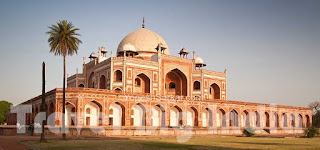Visiting Humayun's tomb is a wonderful experience where you get to see the Mughal architecture and the history of Mughal India. Humayun's tomb is preceded by a tomb with blue dome. The dome has been made with Persian tiles which became very popular since Mughals came to India.
Delhi is all about Mughal architecture and the remains of this very effervescent history shows the glory of Mughal Empire in India. Humayun's tomb is one of the remarkable structures of the Mughal Empire in India.
Humayun's tomb was built in 1565 A.D by Hamida Banu Begum (Humayun's widow).
Near the Humayun's tomb, you will find an enclosure and a mosque, which belongs to Isa Khan. Isa Khan was one of the nobles of Sher Shah who passed away some years prior to Humayun's arrival to Delhi. This particular tom has the beauty of its own but the structure is very different to that of Humayun's tomb.
Humayun's tomb is the main attraction for every visitor. It is very difficult to symbolize the great architecture but we will take you through the course of the whole structure, its architecture and the beauty.
The garden has been maintained very well by the authorities and it does give us a glimpse of what the structure would have looked in past. It had flowers, plants and trees for all seasons, which meant that the place always looked beautiful and visitors were greeted by the fragrance of beautiful seasonal flowers.
Mughals always loved flowers and their fond for gardens can be seen in the architecture of Mughals. As you reach the roof, you will find little porches that are believed to have been used by the students of Madarsa or college where Arabic was taught. The roof itself is a sight seeing place where prominent monuments of Delhi can be seen through naked eyes.
You would find clear view of Jama Masjid and Qutab Minar. A bird's eye view from the roof would show you many ruined tombs and ancient structures belonging to various nobles.
A very special anecdote with reference to Humayun's Tomb is the plight of Bahadur Shah who took refuge in this very tomb in 1857 and later surrendered to the British.
Delhi is all about Mughal architecture and the remains of this very effervescent history shows the glory of Mughal Empire in India. Humayun's tomb is one of the remarkable structures of the Mughal Empire in India.
Humayun's tomb was built in 1565 A.D by Hamida Banu Begum (Humayun's widow).
Near the Humayun's tomb, you will find an enclosure and a mosque, which belongs to Isa Khan. Isa Khan was one of the nobles of Sher Shah who passed away some years prior to Humayun's arrival to Delhi. This particular tom has the beauty of its own but the structure is very different to that of Humayun's tomb.
Humayun's tomb is the main attraction for every visitor. It is very difficult to symbolize the great architecture but we will take you through the course of the whole structure, its architecture and the beauty.
The garden has been maintained very well by the authorities and it does give us a glimpse of what the structure would have looked in past. It had flowers, plants and trees for all seasons, which meant that the place always looked beautiful and visitors were greeted by the fragrance of beautiful seasonal flowers.
Mughals always loved flowers and their fond for gardens can be seen in the architecture of Mughals. As you reach the roof, you will find little porches that are believed to have been used by the students of Madarsa or college where Arabic was taught. The roof itself is a sight seeing place where prominent monuments of Delhi can be seen through naked eyes.
You would find clear view of Jama Masjid and Qutab Minar. A bird's eye view from the roof would show you many ruined tombs and ancient structures belonging to various nobles.
A very special anecdote with reference to Humayun's Tomb is the plight of Bahadur Shah who took refuge in this very tomb in 1857 and later surrendered to the British.


Post a Comment